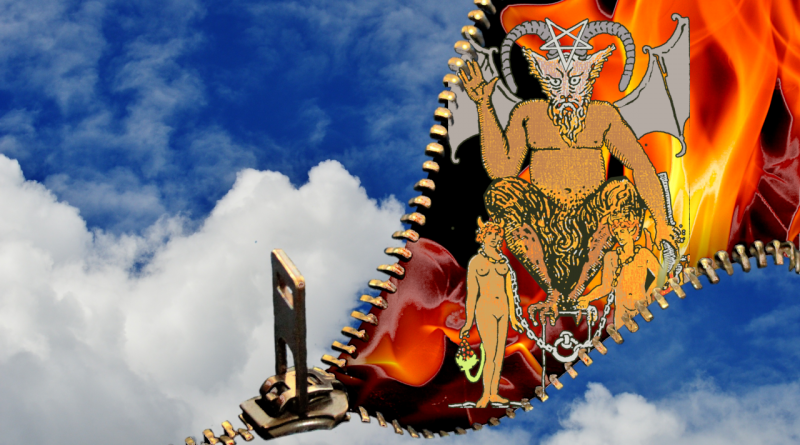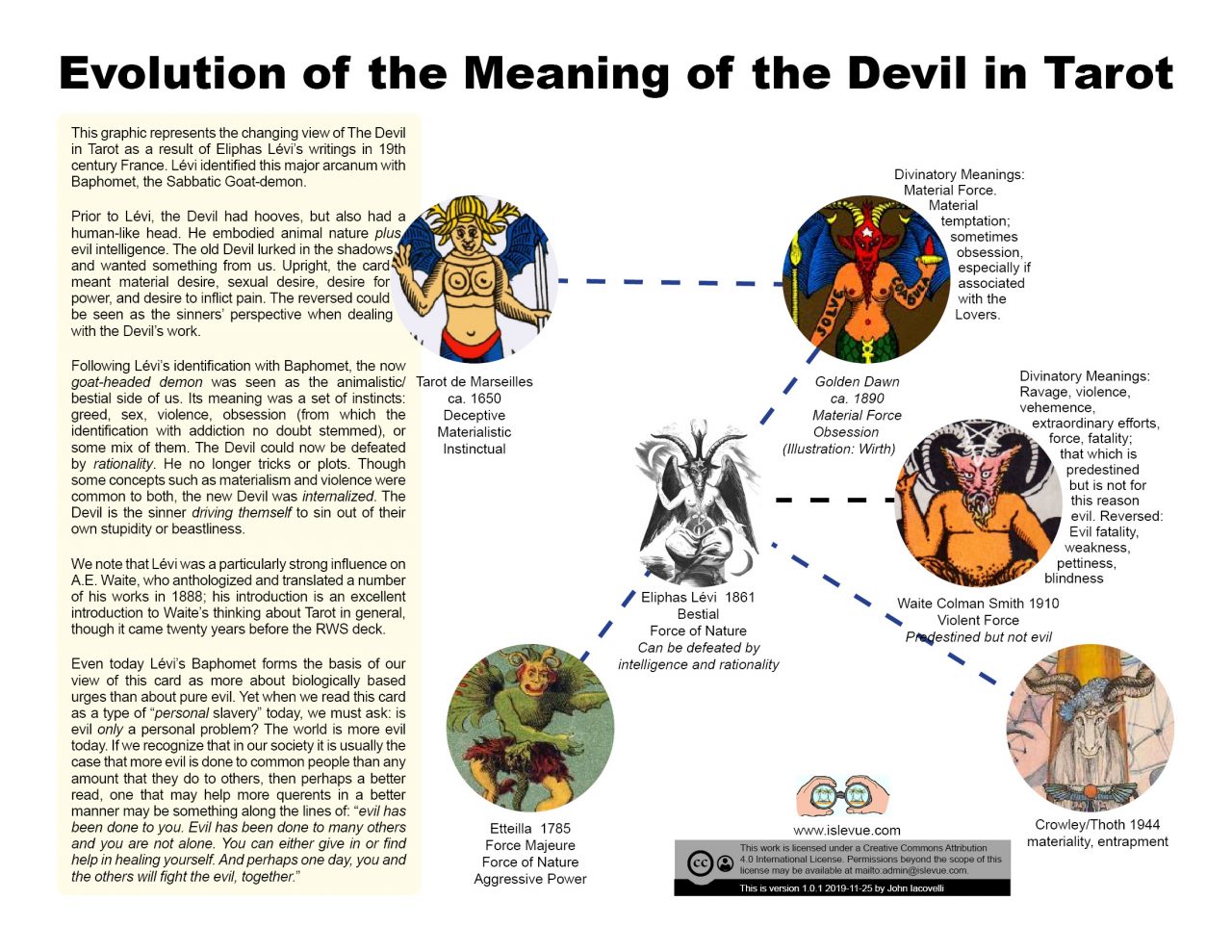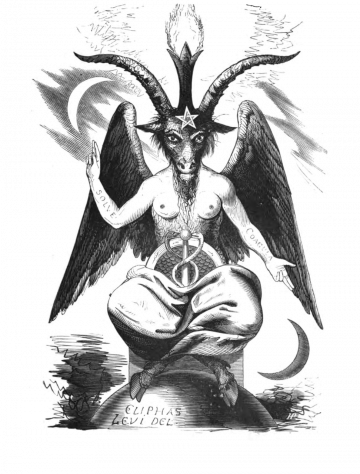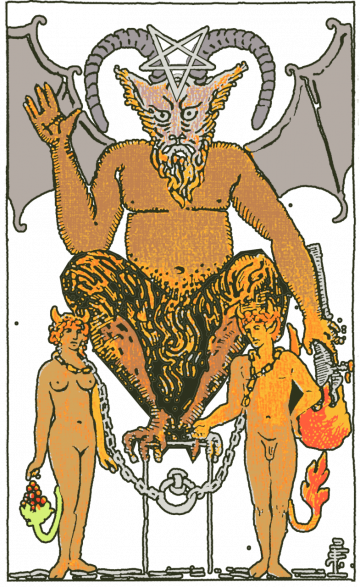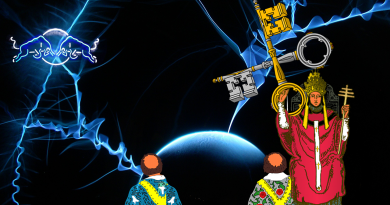The Devil Had a Makeover
A brief note of introduction. This piece comes during a short pause in our One Page Guide series of Venn diagrams/analyses of the minor arcana. The topic was suggested for a new discussion group, Tarotholics, in a new social media venue (an interesting one, adapted from Discord, a gamers’ voice and video chat platform).
The post comes in a new format, which, should it prove popular, will be a focused (one page, one basic thought) document depicting a single aspect of a single major arcanum. So much has already been written about each of the major arcana, I see no need for me to repeat the general literature.
Where I think I have been most successful in the posts at this site is linking Tarot’s “building blocks” together and portraying them graphically (as in the Tarot Wheel and the One Page Guides) so as to better explain the whole. Therefore the format will center around a graphic that sheds light on a single factor that makes that major arcanum what it is, along with a brief amount of text. An “optional” blog commentary will provide information beyond the scope of the graphic (and a platform for me to pontificate from!) 😉
The Devil Within Us
There is a single event to which we can point and say that before it, the Devil major arcanum was one thing, and after that point, another. This occurred in 1861, when Eliphas Lévi published Dogme et rituel de la haute magie. Thereafter Baphomet, the goat-headed demon, replaced Lucifer, the trickster and opponent of God. Baphomet represented bestial urges, our animal nature. In effect, internalized, instinctual evil replaced the external “trickster” evil in the Devil of tarot. This post will posit that external evil does exist in our modern world, and that if we want to be good readers of the tarot, we might do better by the querent to change how we read this card.
Early Tarot’s Devil
First a comment on the Study Group topic for the online meeting: “Stereotypically Scary—Death and the Devil.” They may seem “stereotypical” to us, having been raised on horror films, but death and the devil would have been serious and very, very real to the people who lived in the early renaissance when tarot came into being. Consider Death: Tarot followed the black death by less than a century. Italy, birthplace of Tarocco, was first and worst hit in Europe. It is estimated to have suffered the deaths of one third of its people.
We shall concentrate on just the one card—the Devil. Through literature and art, we know that at that time, the view of the devil was that though he was not a physical being, he was an actual force. The church said (and the church was the authority) he could adopt a form, walk the Earth, interact with people, and do all that he was accused of. Where there was war or violence (unless, of course, the church decreed it, like the Crusades) or other forms of evil, there he was. He was tempter, instigator, and fallen angel. He could be called upon as a real and powerful demon. You could be convicted in court and executed for consorting with the devil.
Modern scholars such as Jeffrey Burton Russell have documented these attitudes. As a New York Times book reviewer said of Burton Russell’s characterization of the attitude towards the devil in the middle ages, “If, as Chesterton claimed, the devil’s greatest triumph was convincing the modern world that he doesn’t exist, Jeffrey Burton Russell means to rob him of his victory.” (Lucifer: The Devil in the Middle Ages 1986).
The tarot reflected this view of the devil: recall that the first Italian decks carried portraits of real people… the Sforza family or other rich families like them. The Devil trumped people that the players might actually have met. He even trumped the Pope!
We can probably consider Camoin’s (he is Jodorowsky’s partner in the restored Tarot de Marseilles) description as a fair summary of the older interpretations of this card:
“Represents mental illusion, lies. Wants to sell us what we already possess. Concept of attachment, animal nature. The greater guardian of the heavenly world, just before entering the House of God. A tyrant. Sadist. Self-assertion. REVERSED : Temptation, bad intentions, excessive manipulation.”
In this description we see a being who was an external influence upon people, embodying animal nature and more. We had a currency he wanted, and he had something we wanted (“wants to sell us”). Upright, those influences were material desire, sexual desire, desire for power, and desire to inflict pain. The reversed could be seen as the sinners’ perspective when the Devil was around.
Eliphas Lévi’s Baphomet
Eliphas Lévi, had a profound effect upon tarot that continues to this day. He wrote on magical ceremony in general, and one of his topics was tarot. He is probably the main theorist who tied qabalah and tarot together, though there were others as far as that goes. His influence on the Devil card in particular is very important because it directly influenced A.E. Waite’s thinking. When we study the RWS deck, we study not just the most popular deck of all time, but all its derivative decks and descendents.
The following excerpts are from: Eliphas Lévi—Transcendental Magic. This is an anthology of his works selected and translated by A.E. Waite who wrote a long introduction as well. The introduction is very, very much worth reading if you want to understand Waite’s thinking. This book came out approximately 20 years prior to the RWS deck.
THE DEVIL, the goat of Mendes, or the Baphomet of the Templars, with all his pantheistic attributes. This is the only hieroglyph which Etteilla perfectly understood and properly interpreted.
The devil of Christianity represents the blind excesses of vital force, but Nature preserves and maintains equilibrium, monstrosities themselves have their cause and serve sooner or later for the nourishment of universal harmony. Fear not, therefore, phantoms; all that is above man must be more beautiful and better than man; below him is the beast, and the beast, however overgrown he may be, must be either the help or the pasturage of man! Cowardly children, fear no more that the devil will eat you! Be men, and it is you who will eat the devil, for the devil, that is, the spirit of absurdity and unintelligence, can never raise himself above the animal. This is what we are to understand by the final and Kabbalistic banquet of Behemoth and Leviathan!
A side note, though not unrelated: The Golden Dawn group placed the Devil under Capricorn, which is known as the “Goat of Fear.” Capricorn symbolizes Enki, whom we discussed when we looked at the Two of Pentacles. He was a Sumerian god-king who may go back to older, aquatic Asian gods. He is shown with horns, and is half fish, hence the scales and fins on some depictions of the devil. The irony is that Enki was a creator god, who was said to have given mankind many gifts. That is why Capricorn is associated with the cornucopia; which in turn also ties into materialism and the Devil. Robert M. Place, who also notes Lévi’s importance, notes the change in the astrological assignment (previously, the Devil was associated with Mercury (note the caduceus in Lévi’s drawing); no doubt due to the heat).
In any case, we can characterize Lévi’s description of the devil as:
- Stress on the animalistic/bestial nature of the devil
- Christianity creates this persona to explain the evil that humans may sometimes do because they cannot control themselves
- Such a persona is unneeded, because Nature rights imbalances over time
- The human is superior to the beast
- Human intelligence triumphs over animal instincts.
And, in fact, if we compare this to Camoin, the change is from trickster to stupid beast. Where he represented an active hurdle (greater guardian), he now represents an error that Nature will self-correct. Previously, he was represented with a human head but hooves instead of feet. Baphomet, with his goat’s head, has lost the human brain that provides the human faculty of reason. This can only be read as a sign that he is the older Devil’s mental inferior. The Thoth card, which represents him as an actual goat, takes this to the extreme.
But most importantly, whereas before the devil was God’s opponent, a formidable being lurking behind problems both individual or global in size, now, human rationality can defeat the devil with the power of reason. The devil creates evil one human heart at a time. That sounds inefficient to me.
Here, scholars such as Burton Russell can help us understand:
The subtraction of the devil has in fact led some modern theologians to evade or trivialise evil. It is curious that at a time when evil threatens to engulf us totally, when evil has already claimed more victims in this century than in all previous centuries combined, that one hears less and less on the subject from theology.
We shall return to this… hold that thought!
A.E. Waite
If you really want to understand what Waite thought about a particular card, ignore the blather and wordiness; instead, focus only on the divinatory meanings, as written in the Pictorial Key to the Tarot. For the majors in particular he wrote much more, but much of those words are about why this or that predecessor or contemporary is wrong and Waite himself is right. Throw out 80% of the Pictorial key, and what remains is the real key to RWS. Bigger than a little white book, but not that much more so.
Waite’s divinatory meanings for the Devil: Upright: “Ravage, violence, vehemence, extraordinary efforts, force, fatality; that which is predestined but is not for this reason evil. Reversed: Evil fatality, weakness, pettiness, blindness.”
Compare this to Golden Dawn: “Material Force. Material temptation; sometimes obsession, especially if associated with the Lovers.”
So we see that in RWS and derivative decks, the Devil is Baphomet, the animal side of our natures. That took on a very forceful tone in Waite’s meanings, but today forms the basis of our view of the Devil as more about sexuality and biologically based urges (such as addiction) than about pure evil.
It seems to me that the “vehemence” that Waite assigned has been even further internalized over time. In Tarot Fundamentals (2015), a marvelous comparative digest of both historical and contemporary tarot thought and art, Berti, Goodwin et al state:
The Devil represents the fallen figure of human vices: anger, sloth, lust, avarice, envy and pride… He represents human flaws. The Devil’s wild freedom and uncensored pursuit of pleasure leads to personal slavery and dependence… The Devil is a mirror reflecting the dark side of the self.
This “personal slavery” of the Devil as represented by Baphomet has ramifications for us when we read this card today. Is evil only a personal problem?
We live in a society which is definitely more violent, and probably more materially ravaging than the one Waite lived in. This is where Burton Russell’s point about the “subtraction” of the devil might enlighten us. Millions die in war; open air slave markets are again in existence; virulent diseases appear in pocket outbreaks; in the U.S., thousands die of inadequate healthcare, addiction kills thousands more, children disappear and the life expectancy of the formerly privileged diminish by years. These problems are far beyond the scope of even collective individuals’ animalistic urges.
If the querent lives in a world in which evil has been done to him or her, how can the Devil, as a card drawn by the querent, refer wholly to something internal and personal? Would it not be gaslighting the querent to say so?
When we read, we often try to guide a querent to a question for which the solution lies within themselves, such as “what may I do to make my relationship with X better.” Yet there is no internal answer to “how can I support my family when the factory where I worked, and every other factory within 1000 miles has closed?” For that matter, if the querent lost that factory job, lost hope, and is now addicted to opioids, is that wholly due to internal weakness on the part of the querent? It is not an easy question to answer. Yet if our society continues on this path, more and more querents will be asking questions like that.
In the commentaries on the minor arcana, I usually try to update Waite’s divinatory meanings for modern times. It may be time to de-emphasize sex and addiction and read the Devil as a card of violent, evil and anti-human influences generated by the worst impulses of societal institutions, not from any one individual. Where generated from internal impulses, evil may be conquered, as the rationalists would have it, but now these forces have corrupted society itself. In such a society, where morality is defined as whatever the law permits, and in which the law can be rewritten in return for campaign contributions, morality and rationality have no meaning beyond their monetary value: nil.
The Devil is a card for our times; undoing the Devil’s makeover might help to understand those times a little better. When that querent poses that question about the factories, it’s time to answer with the truth: that the demon pictured on major arcanum #15 represents the evil nature of our society, and tarot cannot resolve that problem. At least we will have named the right demon.
The answer to our opioid addicted ex-factory worker is “Evil has been done to you. Evil has been done to many others and you are not alone. You can either give in or find help in healing yourself. And perhaps one day, you and I and the others will fight the Devil.
Lucifer: The Devil in the Middle Ages ©1986 Jeffrey Burton RussellTarot Fundamentals ©2015 Lo Scarabeo srl (Giordano Berti; Tali Goodwin; Sasha Graham; Marcus Katz; Mark McElroy; Riccardo Minetti; Barbara Moore, authors).TdM summary ©1999 Philippe CamoinImage of Lévi’s drawing of Baphomet by Eliphas Levi – Eliphas Levi, Public Domain, LinkFeature image background by Alexas_Fotos from Pixabay
Copyright Information: This article’s content by John Iacovelli, for islevue.com is licensed under a Creative Commons Attribution 4.0 International License. Permissions beyond the scope of this license may be available at mailto:admin@islevue.com.
This article’s content by John Iacovelli, for islevue.com is licensed under a Creative Commons Attribution 4.0 International License. Permissions beyond the scope of this license may be available at mailto:admin@islevue.com.
